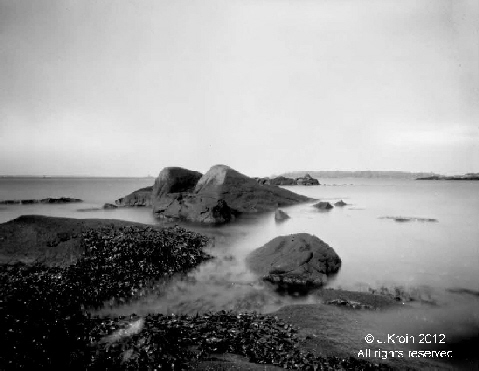
Portfolios:
Pinhole Camera
A Pinhole Camera is a simple camera that does not have
a lens. It is typically a light-proof box with a small hole on one
side. Light from a scene passes through this single point. A projected
image forms on the rear of the box, upside down backwards. The smaller
the hole, the sharper the image and the dimmer the projected image. Due
to the small hole size (f/stop), a pinhole camera requires long exposure
times. If the camera has a larger hole, the image produced is less sharp
and there is a shorter exposure time. A small f/stop produces images having
nearly infinite depth-of-field where most of the subject is in focus.
The History: Basic optical rules of the pinhole were
commented on in 5th century Chinese texts. By the 1500's the pinhole was
mainly used for scientific purposes in astronomy and, fitted with a
lens, as a drawing aid for artists. For those purposes, the term camera
obscura ("dark room") came to mean a room, tent or box with a lens
aperture. Photographers made the first pinhole camera photographs in
1850's, beginning of the term "pinhole" or "pin-hole" camera. The camera
became popular in the 1890s, gradually losing appeal. There was a
rebirth of interest in the 1970's. The internet has increased exposure
and interest of more people to photographs made by these cameras.
About the Photographs on this Website
Pinhole camera photography creates special challenges.
The pinhole size
is typically small, therefore, low light reaches the film. Exposure
times must be long. Photographers can make easy photographs where
subjects do not move. With long exposure times, moving water and
clouds produce photographs with luminous effects. Having soft focus,
recorded buildings and places appear as if photographed in historic
style. There is a need to anticipate what will occur during the exposure time.
If objects are likely to move during the exposure, what will be the result? If
light is changing with clouds, it will alter shadows. If bright light falls upon
the pin hole it may cause light streaks. Sometimes resultant photographs have
elements of surprise. With long time exposures, people and other
objects moving during the exposure may disappear. If they are in the
same place a long enough time to be recorded on the film, they may
appear as ghosts.
Coney Island,
Brooklyn, New York, is an ever changing area. It is a wonderful place
to photographically capture a place ever changing. Historically it has been a
summer playground for more than a century. Extremes have always been in vogue,
especially amusement park rides, fast food, and sometimes strange folk. During
the past year the area has had upgrades. Taking photographs there has been a
challenge since what is photographed today may be renewed tomorrow.
All photographs on this website were taken by
J. Kroin
Camera: A wooden box
(on a tripod). Focal length = 75mm (about 3"). F-stop 1/232. Pinhole = 0.013" (about
the diameter of a tiny #20 sewing needle). Shutter is a simple flap.
Film: Ilford Ortho Plus, black and white, 4"x5"
sheet film.
Exposure times (typical): bright summer sun (40-55 sec.), bright winter sun
(55-75 sec.), dull sun (75-90 sec.), shade (6-12 min.).
Coney Island and a Few Ghosts
Download full version of the book (large file): Coney Island and a Few Ghosts
The book Coney Island and a Few Ghosts has been published in a limited edition: read about it
To Purchase
Photographs and other Information Contact:
photos@rootinghormones.com
All photographs © J. Kroin 2012. All Rights Reserved